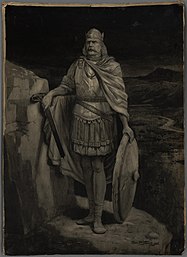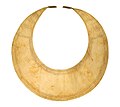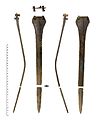Prehistoric Wales
Prehistoric Wales in terms of human settlements covers the period from about 230,000 years ago, the date attributed to the earliest human remains found in what is now
Palaeolithic
The earliest known human remains discovered in modern-day Wales date from 230,000 years ago. An early
The
Mesolithic
Following the last
Anglesey's permanent settlement has a history beginning c. 9,000 years ago during the Mesolithic (European) period at the Aberffraw bay, Trwyn Du (Welsh: Black nose) excavated site. Millenniums later, around 2,000 BC was when a Bronze Age kerb cairn (bowl barrow) was built covering the original Trwyn Du artifact deposit of 7,000 thousand Mesolithic flint tools and 2 axes.[17][18][19][20]
Neolithic
This section contains an unencyclopedic or excessive gallery of images. |

The earliest farming communities are now believed to date from about 4000 BC, marking the beginning of the
Three main types of megalithic tomb are found in Wales, the
A number of houses from the Neolithic period have also been found in Wales, most notably the settlement at
-
Bryn Celli Ddu 'Pattern Stone' (replica)
-
Siambr gladdu Oes y Cerrig, dolmen, c. 3000 BC.[27]
-
Maen Ceti (Arthur's stone) burial site, Gower
-
Bryn Gwyn stones
-
The Maesmor mace-head, c. 3000-2500 BC.[28]
The Bronze Age
This section contains an unencyclopedic or excessive gallery of images. |
Metal tools first appeared in Wales about 2500 BC with the
Burial practices in the Bronze Age differed from the communal tombs of the Neolithic period, with a change to burial in
From about 1250 BC there was a deterioration in the climate which became more marked from about 1000 BC, with higher rainfall and much lower summer temperatures. This led to an increase in peat formation and probably the abandonment of many upland settlements.[33] It has been suggested that this led to conflict and to changes in social organization, with the earliest hillforts appearing about 800 BC.[34]
The Late Bronze Age saw the development of more advanced bronze implements, with weapons becoming increasingly common.[35] While the weapons reflect introduced styles, there are pronounced regional variations in the styles of tools, particularly axes. On the basis of tool types, Wales can be divided into four regions, These were, the Ordovices (Mid to North Wales & Anglesey), the Deceangli (North East Wales), the Demetae (South West Wales), and the Silures (South East Wales). These regions show an approximate correspondence to the territories of the tribes later recorded in these areas by the Romans.[36]
-
Gold
-
Gold lunula, Bell Beaker culture, 2400-2000 BC
-
The Mold Cape, c. 1900-1700 BC
-
The Caergwrle Bowl, c. 1300 BC
-
Gold and Bronze hoard from Wrexham, 1300-1150 BC
-
Bronze rapier sword
-
Bronze socketed axes
-
Horse harness
The Iron Age
This section contains an unencyclopedic or excessive gallery of images. |


The earliest iron implements found in Wales come from
Over 600 hillfort were built in Wales and throughout the British Isles from c. 800 BC.

Some Celtic tribes originated in
A particularly significant find from this period was made in 1943 at Llyn Cerrig Bach on Anglesey, when the ground was being prepared for the construction of a Royal Air Force base. The cache included weapons, shields, chariots along with their fittings and harnesses, and slave chains and tools. Many had been deliberately broken and seem to have been votive offerings.[49] These finds are considered to be one of the most important collections of La Tène metalwork discovered in Britain. Pottery on the other hand is fairly rare in Wales during this period and most of what has been found appears to be imported.[50]
The La Tène culture is traditionally associated with the
The prehistoric period ended with the arrival of the
-
Copper alloy fob withtriskeledesign
-
Bronze bowls and wine strainer with triskele design from Langstone, Newport.[54]
-
Reconstruction of an Iron Age roundhouse at Melin Llynon, Anglesey
-
Reconstruction of an Iron Age chariot.[56]
-
Remains of dry-stone fortifications at Tre'r Ceiri hillfort, Gwynedd
-
Tre'r Ceiri hillfort, artist's reconstruction
-
Penycloddiau hillfort remains,
Notes
| History of Wales |
|---|
 |
- ^ Lynch 2000, p. 6.
- ^ People's Collection a.
- ^ People's Collection b.
- ^ People's Collection c.
- ^ People's Collection d.
- ^ Lynch 2000, p. 16.
- ^ Whittle 1992, p. 4.
- ^ Jacobi & Higham 2008, pp. 898–907.
- ^ Richards & Trinkaus 2009, pp. 16034–9.
- ^ Oxford Museum of Natural History.
- ^ Lynch 2000, pp. 18–19.
- ^ Lynch 2000, p. 41.
- ^ Lynch 2000, p. 39.
- ^ Lynch 2000, p. 23.
- ^ Lynch 2000, p. 312.
- ^ Lynch 2000, p. 38.
- ^ "Scheduled Monuments- Full Report". cadwpublilc-api.azurewebsites.net. Retrieved 29 August 2023.
- ^ a b c "Prehistoric Wales". cadw.gov.wales. Retrieved 28 August 2023.
- ^ "Trwyn Du Cairn near Aberffraw, Overlying A Mesolithic Site (302323)". Coflein. RCAHMW.
- ^ "Aberffraw to port Cwyfan, Anglesey" (PDF). walescostalpath.gov.uk.
- ^ Lynch 2000, pp. 34–42, 58.
- ^ "Wales' earliest village?". archaeology.co.uk. 5 October 2017.
- ^ Lynch 2000, p. 42-43.
- ^ Lynch 2000, p. 54.
- ^ Lynch 2000, p. 56-57.
- ^ "Bryn Cello Ddu". cadw.gov.wales. Retrieved 23 October 2023.
- ^ "Siambr Gladdu Tŷ Newydd". cadw.llyw.cymru. Retrieved 23 October 2023.
- ^ "A Stone Age masterpiece - A Mace-head from North Wales". National Museum of Wales.
- ^ Lynch 1995, pp. 39–40.
- ^ Lynch 2000, p. 99.
- ^ Lynch 2000, p. 126.
- ^ Lynch 2000, p. 138.
- ^ Lynch 2000, pp. 140–145.
- ^ Lynch 2000, p. 150.
- ^ Lynch 2000, p. 180.
- ^ Lynch 2000, p. 184.
- ^ "Early Bronze Age gold disc". National Museum Wales.
- ^ "Copper mining, prospection and the Beaker Phenomenon in Wales – The significance of the Banc Tynddol gold disc". 2016.
- ^ Cunliffe 1978, p. 290.
- ^ "Early Celtic Societies in North Wales project – Excavations at Meillionydd 2010". Prifysgol Bangor University. 2010. Archived from the original on 20 December 2016. Retrieved 2 September 2023.
- ^ Lynch 2000, p. 147.
- ^ "Din Sylwy or Bwrdd Arthur (93842)". Coflein. RCAHMW.
- doi:10.11141/ia.48.6.
- ^ Foster & Daniel 2014, p. 130.
- ^ a b "Din Lligwy Hut Group". cadw.gov.wales. Retrieved 29 August 2023.
- ^ RCAHMW, An Inventory of the Ancient Monuments in Anglesey, p. LXXX, at Google Books
- ^ "The Celts in Wales". sarahwoodbury.com. 5 June 2019. Retrieved 29 August 2023.
- ISBN 1851094407.
- ^ Lynch 1991, p. 249-77.
- ^ Lynch 2000, p. 199.
- ^ Cunliffe 1978, p. 3.
- ^ Lynch 2000, p. 213.
- ^ "The Capel Garmon Firedog". National Museum of Wales.
- ^ "The Langstone treasure". National Museum of Wales.
- ^ "The Penbryn Spoons". British Archaeology at the Ashmolean Museum.
- ^ "Iron Age chariot". National Museum of Wales.
See also
- List of Cadw properties
- Archaeology of Wales
- Early history of Ireland
- Prehistoric Britain
- Prehistoric Scotland
- Prehistoric Europe
Bibliography
- Cunliffe, Barry W. (1978). Iron age communities in Britain : an account of England, Scotland, and Wales from the seventh century BC until the Roman conquest (2d ed.). London: Routledge & Kegan Paul. ISBN 071008725X.
- Davies, John (1994). A history of Wales. London: Penguin Books. ISBN 0-14-014581-8.
- Foster, I.Ll.; Daniel, Glyn (24 October 2014). Prehistoric and Early Wales (1st ed.). London: Routledge.
- Jacobi, R.M.; Higham, T.F.G. (November 2008). "The "Red Lady" ages gracefully: new ultrafiltration AMS determinations from Paviland". Journal of Human Evolution. 55 (5): 898–907. PMID 18929395.
- Lloyd, John Edward (1911). A History of Wales: From the Norman Invasion to the Edwardian Conquest. Barnes & Noble Publishing. ISBN 978-0-7607-5241-8.
- Lynch, Frances (1995). Gwynedd. London: H.M.S.O. ISBN 0-11-701574-1.
- Lynch, F. M. (1991). Prehistoric Anglesey : the archaeology of the island to the Roman conquest (2nd ed.). Llangefni: Anglesey Antiquarian Society. ISBN 0950019976.
- Lynch, Frances (2000). Prehistoric Wales. Stroud [England]: Sutton Pub. ISBN 0-7509-2165-X.
- "The 'Red Lady' of Paviland". oumnh.ox.ac.uk. Oxford University. Retrieved 29 March 2023.
- "Upper jaw of a Neanderthal child aged around 8 years old". Peoples Collection Wales. Retrieved 29 March 2023.
- "The oldest people in Wales - Neanderthal teeth from Pontnewydd Cave". Peoples Collection Wales. Retrieved 29 March 2023.
- "Coygan Cave (Carmarthenshire). No human remains have been found here, just a handful of tools that show that Neanderthals used the cave briefly". Peoples Collection Wales. Retrieved 29 March 2023.
- "The Cave Men of Ice Age Wales". Peoples Collection Wales. Retrieved 29 March 2023.
- Pitts, M (2006). "Sensational new discoveries at Bryn Celli Ddu". British Archaeology. 89: 6.
- Richards, MP; Trinkaus, E (September 2009). "Out of Africa: modern human origins special feature: isotopic evidence for the diets of European Neanderthals and early modern humans". Proc. Natl. Acad. Sci. U.S.A. 106 (38): 16034–9. PMID 19706482.
- Taylor, J. A. (1980). Culture and environment in prehistoric Wales : selected essays. Oxford, Eng.: B.A.R. ISBN 0-86054-079-0.
- Whittle, Elisabeth (1992). A guide to ancient and historical Wales. Glamorgan and Gwent. London: HMSO. ISBN 0117012211.
External links
 Media related to Prehistoric Wales at Wikimedia Commons
Media related to Prehistoric Wales at Wikimedia Commons- Royal Commission on the Ancient and Historical Monuments of Wales
- Artifacts from Pontnewydd Cave held on Gathering the Jewels
- Artifacts from Coygan Cave held on Gathering the Jewels
- Artifacts from Paviland Cave held on Gathering the Jewels
- Mesolithic stone beads from Nabs Head, Pembrokeshire, held on Gathering the Jewels
- Mesolithic fins from Rhuddlan held on Gathering the Jewels
- Pentre Ifan Cromlech/Dolmen in Pembrokeshire, Wales
- Carreg Coetan Arthur Cromlech/Dolmen in Pembrokeshire, Wales
- The Prehistoric Monuments in Wales, Herbert E. Roese


![Bryn Celli Ddu, a late Neolithic chambered tomb on Anglesey.[26]](http://upload.wikimedia.org/wikipedia/commons/thumb/d/d7/BrynCelliDdu3.jpg/120px-BrynCelliDdu3.jpg)
![Siambr gladdu Oes y Cerrig, dolmen, c. 3000 BC.[27]](http://upload.wikimedia.org/wikipedia/commons/thumb/6/64/Siambr_gladdu_Oes_y_Cerrig_-_Neolithic_burial_chamber_from_c._3%2C000_CC%2C_Dyffryn_Conwy%2C_Wales_03.jpg/120px-Siambr_gladdu_Oes_y_Cerrig_-_Neolithic_burial_chamber_from_c._3%2C000_CC%2C_Dyffryn_Conwy%2C_Wales_03.jpg)


![The Maesmor mace-head, c. 3000-2500 BC.[28]](http://upload.wikimedia.org/wikipedia/commons/thumb/6/66/NMW_-_Keulenkopf.jpg/120px-NMW_-_Keulenkopf.jpg)
![Gold Banc Ty'nddôl sun-disc. Bell Beaker culture, 2450-2150 BCE.[37][38]](http://upload.wikimedia.org/wikipedia/commons/thumb/c/c9/Disc1.png/105px-Disc1.png)







![Capel Garmon Firedog, from Conwy.[53]](http://upload.wikimedia.org/wikipedia/commons/thumb/8/8a/Capel_Garmon_Firedog.jpg/120px-Capel_Garmon_Firedog.jpg)

![Bronze bowls and wine strainer with triskele design from Langstone, Newport.[54]](http://upload.wikimedia.org/wikipedia/commons/thumb/7/75/Langstone_bronze_bowls_and_wine_strainer.jpg/120px-Langstone_bronze_bowls_and_wine_strainer.jpg)

![The Penbryn Spoons from Castell Nadolig, possibly used for divination.[55]](http://upload.wikimedia.org/wikipedia/commons/thumb/e/e2/Iron_Age_Spoons_from_Penbryn_on_display_in_the_Ashmolean_Museum.jpg/120px-Iron_Age_Spoons_from_Penbryn_on_display_in_the_Ashmolean_Museum.jpg)

![Reconstruction of an Iron Age chariot.[56]](http://upload.wikimedia.org/wikipedia/commons/thumb/b/bc/Nachgebauter_keltischer_Streitwagen.png/120px-Nachgebauter_keltischer_Streitwagen.png)



